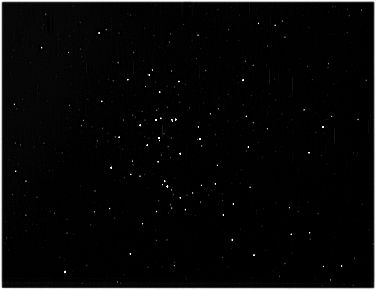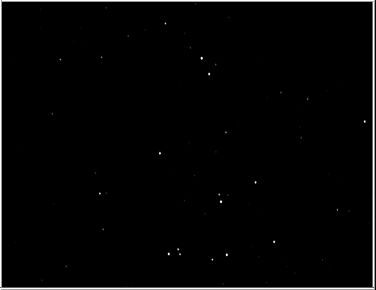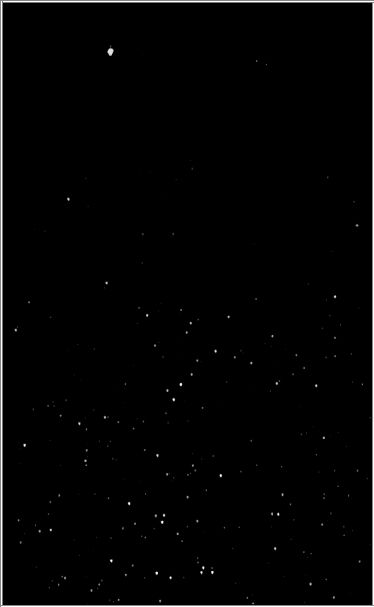 |
This cluster has several names, M44, NGC2632, Praesepe, or, most commonly, the Beehive Cluster. It is very large at about 95 arc-minutes (about three times the width of the full Moon), and bright enough to be seen with the naked eye in dark skies. Ptolomy described it as "The nebulous mass in the breast" of the crab, and Galileo first saw it through a telescope in 1609 and recognised that it contained 40 stars. It is now known to contain at least 200 stars and maybe as many as 250. It is 577 light-years away and about 16 light-years across. Charles Messier added it to his catalogue in 1769.
This is not a deep picture. It was taken through a light layer of high cloud. The Moon was nearby and surrounded by a light halo.
Date and Time: 11th May 2008 21:17 to 21:44 UT
Camera: MX716
Telescope: 135 mm SLR lens at f/5.6
Capture: Star_MX7. Exposure 10 sec, 128 frames
Processing: Registax. 111 frames stacked, wavelets 1-2 = 10, histogram 26-87 |
|

|
When I first saw the picture above, I couldn't quite understand why it is called the Beehive Cluster. This was partly because I had it up side down* (it is corrected now). However, this picture, taken with even less depth than the previous one, and showing only the centre of the cluster shows just why it is called the Beehive Cluster. Although there was no Moon this time, I think there was some light high cloud up there so that only the brighter stars are showing despite the larger aperture of the lens. However, if you move your mouse over the picture, you will see the same picture with the gamma increased to 5 which reveals a lot more stars (and obscures the asterism).
Date and Time: 16th April 2010 22:09 to 22:13 UT
Camera: MX716
Telescope: ST80 with skyglow and IR-block filters
Capture: Star_MX7. Exposure 10 sec, 10 frames
Processing: Registax. 9 frames stacked, wavelets 1-2 = 5, histogram 10-255
*For some reason both RegiStax and K3CCDTools load fit files written by star_mx7 mirrored vertically. . |
|

|
Mars joined the Beehive Cluster. Here Mars, at the top of the picture, was just under 1° from the centre of the cluster, which was about as close as it got this year. It can pass right through the cluster, and will do so on 1st October 2011. Unfortunately it will only take Mars about 12 hours to pass through the main part of the cluster and, as far as I am concerned, most of that time Mars will be below the horizon.
The picture is a mosaic of 3 images joined by iMerge.
Date and Time: 16th April 2010 22:09 to 22:25 UT
Camera: MX716
Telescope: ST80 with skyglow and IR-block filters
Capture: Star_MX7. Exposure 10 sec, 15 frames per section
Processing: Registax. 15 frames stacked, wavelets 1-2 = 5, histograms as appropriate
|

